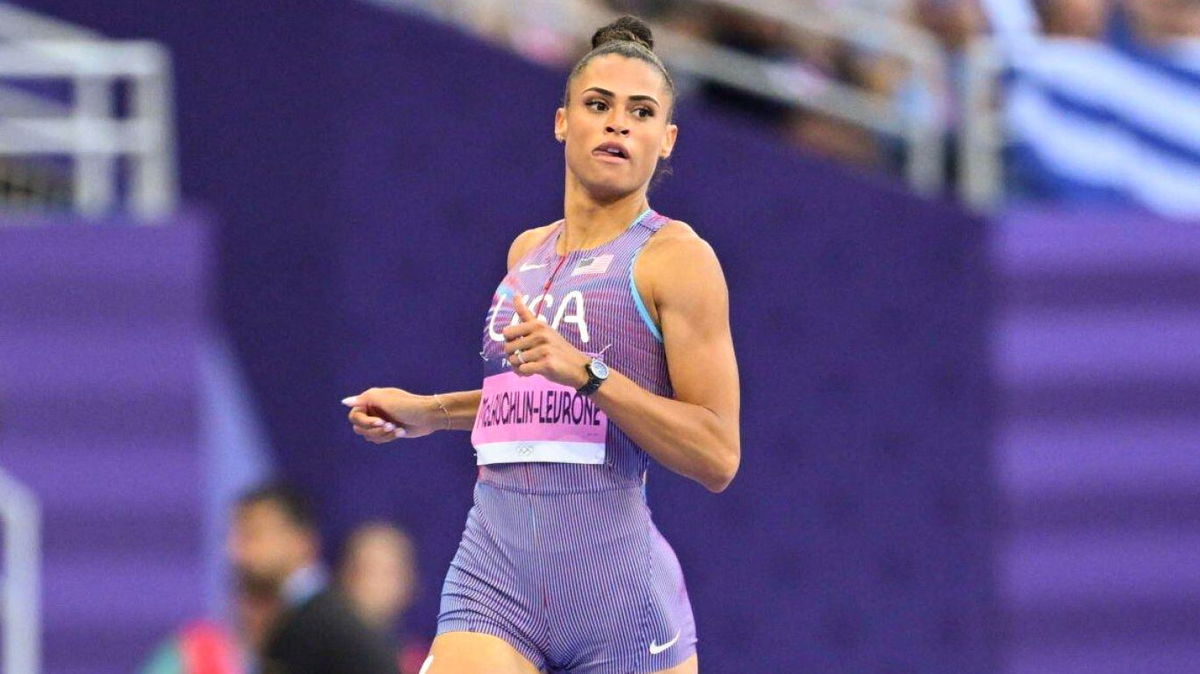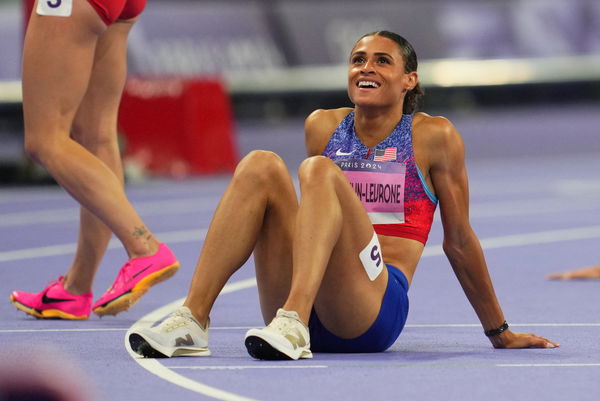
Imago
Image via IMAGO

Imago
Image via IMAGO
Sydney McLaughlin-Levrone has forced the track and field world to take notice in Tokyo. In Tuesday’s 400-meter semifinal at the World Championships, the American ran 48.29 seconds, a performance that not only advanced her to the final but also erased Sanya Richards-Ross’s long-standing national record of 48.70 from 2006. It was the 11th-fastest time in history, the best mark ever by an American, and a run she admitted caught her off guard. Speaking to NBC Sports’ Lewis Johnson, she said, “I didn’t expect to run this fast today. And I still have more to show.”
Watch What’s Trending Now!
Richards-Ross’s record had survived nearly two decades, but McLaughlin-Levrone’s breakthrough underscored her ability to translate her dominance in the 400-meter hurdles into the flat event. A two-time Olympic gold medalist in her specialist discipline and a multiple relay champion, she has now put herself on a direct path toward the 47.60 world record established by Marita Koch in 1985. The controversy surrounding Koch’s era has only heightened anticipation that a clean athlete might soon surpass it. McLaughlin-Levrone herself has suggested Tuesday’s time is not the limit, explaining after her run, “This race definitely gives me confidence for the final.”
Yet the discussion since the semifinals has centered on more than her speed. The lane assignments for Thursday’s final have ignited considerable debate among observers and fans. McLaughlin-Levrone has been placed in lane five, traditionally considered favorable for balance and visibility, but her chief rivals occupy positions that could prove decisive. Marileidy Paulino, the 2024 Olympic champion who clocked 48.17 last year, will run from lane nine. Salwa Eid Naser, a former world champion, is in lane seven, while Britain’s Amber Anning, who advanced with 49.38, lines up in lane six.
ADVERTISEMENT
Lane assignments for the women’s 400m final at the Tokyo World Championships!!👀 https://t.co/JuSRtEf6Kq pic.twitter.com/shu6wBePD4
— Track & Field Gazette (@TrackGazette) September 16, 2025
Lane allocation in the 400 meters is rarely a trivial matter. The geometry of the track means that the inner lanes force tighter turns, often slowing athletes. Middle lanes, such as four to six, are widely regarded as optimal, while the outermost lanes provide a more generous curve but leave runners isolated without visual reference to competitors. In this case, Paulino’s position in lane nine has prompted particular scrutiny, as she will run the entire race blind to the rest of the field.
The result is a final that promises both tactical intrigue and historical weight. Paulino has already declared, “God and I will make history here,” while McLaughlin-Levrone carries both momentum and expectation after lowering the American record. Koch’s 47.60 remains the target, but the race itself may hinge on how competitors manage their assigned lanes as much as their raw ability.
ADVERTISEMENT
With the final scheduled for Thursday, September 18, at 9:24 p.m. ET, the stage is set for one of the most consequential women’s 400-meter races in years. Whether McLaughlin-Levrone’s form and lane five advantage prove decisive, or whether Paulino and Naser can overcome less conventional draws, the outcome will ripple through conversations not only about this championship but about the history of the event itself. And Sydney’s placement in lane five has become the focal point of anticipation, with fans dissecting how lane assignments could shape the outcome of the 400m world final.
ADVERTISEMENT
Sydney McLaughlin-Levrone’s lane draw sparks high-stakes drama for 400m world final
Jamaican contender Nikisha Pryce drew lane two despite having the third-fastest qualifying time. This sparked the fan’s remark, “3rd fastest time and they put her in lane 2🙃.” The inside lanes are considered the toughest because of tighter turns and reduced rhythm, which makes her placement a point of contention, given her strong semifinal performance.
Sydney McLaughlin-Levrone’s position in lane five is viewed as advantageous, prompting the reaction, “Sydney got the perfect lane. She gets to see her competition the whole way.” Middle lanes are typically favored since they allow athletes to monitor rivals ahead and behind, offering a tactical edge in pacing and adjustments during the race.
Top Stories
Prayers Pour In From Terrell Owens as 275lbs Former Cowboys Player Announces Major Health News

NFL Make Final Punishment Decision on Controversial Patrick Mahomes Incident

Footage Surfaces of Florida Police Arresting NASCAR Veteran Over Disturbing Public Misbehavior

Dan Campbell Loses Faith in Locker Room After Clearing Stance on NFL Officials’ Controversial Decision

Mike Tomlin Breaks Silence on DK Metcalf Incident as Steelers WR Risks $277K Punishment

Olympic Champion Dominique Dawes Confirms Heartbreaking Outcome in Missing Family Member Search


Reuters
Paris 2024 Olympics – Athletics – Women’s 400m Hurdles Final – Stade de France, Saint-Denis, France – August 08, 2024. Gold medallist Sydney McLaughlin-Levrone of United States celebrates after winning and setting a new world record. REUTERS/Aleksandra Szmigiel
The placement of the main contenders sparked the reaction, “Poor lane for Paulino, excellent lane for Sdy. Sdy can see all her main competitors.” Marileidy Paulino, positioned in lane nine, will run blind to the field, while McLaughlin-Levrone in lane five is perfectly positioned to observe both Paulino in the outer lane and Salwa Eid Naser just ahead in lane seven.
ADVERTISEMENT
Despite concerns, Paulino’s wide draw led to the comment, “Paulino may possibly run the race of her life from the outside lane.” Outer lanes reduce visual pressure from competitors, allowing athletes to focus solely on their rhythm. Historical examples, such as Wayde van Niekerk’s Rio 2016 world record from lane eight, illustrate how such placements can be turned into an advantage.
A fan emphasized tactical visibility, noting, “Oh my goodness…..for Syd to be able to see the best 4 women (on rankings) in front of her…And as fast as Nassar gets out…to be able to see & counter any moves. ‘Historically Epic’ is the phrase for this race.” From lane five, McLaughlin-Levrone can track Amber Anning, Naser, and others ahead, responding instantly to mid-race surges.
ADVERTISEMENT
The simple remark from a fan reading, “Only Sydney get good lane,” reflects the belief that McLaughlin-Levrone benefited most from the draw. With Pryce stuck on the difficult inside, Paulino isolated in lane nine, and Naser slightly offset in lane seven, Sydney’s central placement appears uniquely favorable compared to her direct competitors.
Lane nine also drew optimism, as one track enthusiast added, “Lane 9 Actually might be the best thing for Paulino. She can run her race. Just like wayde van niekerk in 2016 Rio 400m. Outside lane isn’t a disaster.” By running without distraction, Paulino has the chance to replicate van Niekerk’s historic execution, using clear space to establish an aggressive and controlled pace. Wayde van Niekerk achieved a legendary performance at the Rio Olympics, clocking the world record time of 43.03 seconds. And all that he did while ruling lane 8.
ADVERTISEMENT
ADVERTISEMENT
ADVERTISEMENT

